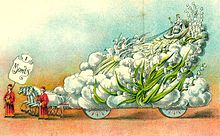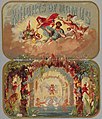Knights of Momus
 | |
| Abbreviation | KoM |
|---|---|
| Named after | Momus |
| Formation | 1871 |
| Founded at | New Orleans, LA. |
| Type | Carnival Krewe |
| Location |
|
The Knights of Momus (KoM) was founded in 1872 and was the second-oldest parading Old Line Krewe in New Orleans Carnival after the Mistick Krewe of Comus and is the third oldest krewe to continuously present a tableau ball, after the Twelfth Night Revelers in 1870.

For over 100 years, the Momus parade was a fixture of the New Orleans Mardi Gras parade schedule, parading annually on the Thursday before Fat Tuesday. Since Momus was the Greek god of mockery, the themes of Momus parades typically paid homage to the organization's namesake with irreverent humor and biting satire. The 1877 parade theme, "Hades, A Dream of Momus," caused an uproar when it took aim at the Reconstruction government established in New Orleans after the Civil War. Attempts at retribution by local authorities were largely unsuccessful due to the secrecy of the membership.
In 1991, New Orleans City Council member Dorothy Mae Taylor passed an ordinance that required social organizations, including Mardi Gras Krewes, to certify publicly that they did not discriminate on the basis of race, gender, handicap, or sexual orientation, in order to obtain parade permits and other public licensure. In effect, the ordinance required these, and other, private social groups to desegregate. Momus was one of three historic krewes (with the Mistick Krewe of 1857 and KoP of 1882) that withdrew from parading rather than comply.[1]
Two federal courts later declared that the ordinance was an unconstitutional infringement on First Amendment rights of free association, and an unwarranted intrusion on the privacy of the groups subject to the ordinance.[2] The Supreme Court refused to hear the city's appeal from this decision. Nevertheless, the Momus parade never returned to the streets of New Orleans, although the group still conducts an annual bal masqué on the Thursday before Mardi Gras.
The Louisiana Debating and Literary Association a.k.a. The Louisiana Club
[edit]Much like The Pickwick Club was founded as the public facade of The Mistick Krewe, The Louisiana Literary and Debating Society was founded as the public facade of Knights of Momus. Unlike The Pickwick Club/Mistick Krewe relationship, the Knights of Momus and The Louisiana Club are still highly intact,[3] much like the Stratford Club and the High Priests of Mithras. Unlike The Boston Club or The Pickwick Club, the Louisiana Club is completely closed, and will not admit anyone through its portals that is not a member. It is rumored most of the club is related.[4][5]
Gallery
[edit]Floats and costumes
[edit]-
Rapp the Gnome King 1878
-
The Prisoner of Chillion 1902
-
The Vision of Manfred 1902
-
MOMUS 1907
-
Title 1907
-
Black Cats 1909
-
Pinoochio 1916
Invitations
[edit]-
1873
-
1878
-
1884
-
1885
-
1885
-
1887
-
1878 Admittance Card
-
1891
-
1907
-
1915 Dance Card
-
1972
Bulletin
[edit]-
1883
-
1884
-
1887
-
1902 Byron
-
1923 Throw the Looking Glass
Parade
[edit]-
1916
-
1938
-
1953
Program
[edit]-
1876
-
1891
-
1896
Galveston
[edit]The Knights of Momus ("KOM") were a Mardi Gras society in Galveston, Texas, founded in 1871.[6] The original Knights of Momus went defunct around the time of World War II. A new group was founded in the mid-1980s, and seeking to rekindle the spirit of the original group, adopted the Momus name. The group was named after the Greek god Momus.
See also
[edit]References
[edit]- ^ Nolan, Bruce (12 February 2012). "Bitter Mardi Gras debate of race, class evolves 20 years later into a diverse celebration". The Times-Picayune. Archived from the original on 2012-02-14. Retrieved 21 November 2014.
- ^ The decision of the Fifth Circuit Court of Appeals appears at volume 42, page 1483 of the Federal Reporter (3rd Series), or 42 F.3d 1483 (5th Cir. 1995).
- ^ New Orleans in the Twenties. N.p., Pelican Publishing. pp.193
- ^ Gill, James. Lords of Misrule: Mardi Gras and the Politics of Race in New Orleans. The United States, University Press of Mississippi, 1997.pp 222
- ^ Woods, Clyde. Development Drowned and Reborn: The Blues and Bourbon Restorations in Post-Katrina New Orleans. Greece, University of Georgia Press, 2017. pp.53
- ^ Kearney, Sid (30 January 2014). "Make the most out of your trip to Galveston for Mardi Gras". Houston Chronicle. Retrieved 21 November 2014.





























